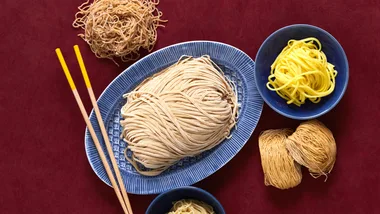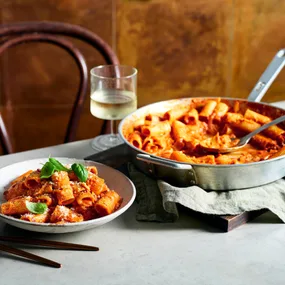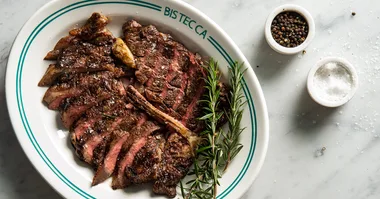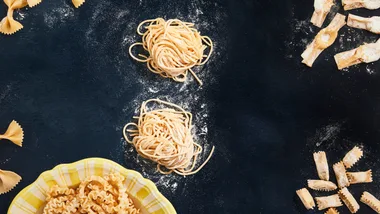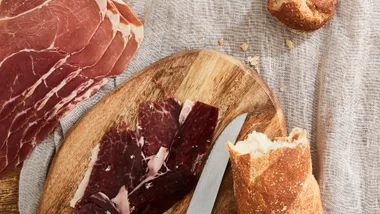Among our favourite Japanese larder standbys, we count a good light shoyu, furikake (the confetti-like seasoning that makes plain rice sing), and soba noodles.
Soba noodles are typically made with buckwheat flour, with a portion of wheat flour added for stability. We like to use Japanese soba noodles made from 100 per cent organic buckwheat flour. Not only are they gluten-free, we prefer the flavour and texture; Japanese grocers and Asian supermarkets stock a wide selection of styles, green tea among them.
The soba noodles from Australian brands Hakubaku and Spiral Foods, available at supermarkets, are also good choices. The first is a blend of wheat and buckwheat flours; the latter is organic and all buckwheat. It’s worth noting that 100 per cent buckwheat soba noodles break easily during cooking, so be gentle. Carefully slide them from the packet into a large saucepan of boiling water, separating them as they go in, and give them only a gentle stir as they come up to the boil.
It’s traditional to halt the cooking of the noodles by adding cold water to the pot. As Jane Lawson, author of Zenbu Zen and operator of Japanese Zenbu Tours, notes, “Japanese chefs arrest the boiling water once or twice with half a cup of cold water, then bring up to the boil again, which helps cook them more slowly and maintain a good texture.”
Whether you’re eating them hot or cold, refresh soba in a large bowl of cold water after cooking – the starch sticks easily once the liquid is drained away. Serve them in soups in winter, and chilled with a dipping sauce in summer, or toss them in a salad. A little grated daikon or ginger complements the earthy buckwheat flavour nicely.
Soba salad with red cabbage, coriander and cucumber
Serves 4 as a light meal
Bring 60ml (¼ cup) brown rice vinegar, 1 tbsp caster sugar and 1 tbsp water to a simmer in a small saucepan over medium heat, stirring to dissolve sugar. Transfer to a large bowl and cool, then whisk in 2 tbsp olive oil and 1½ tbsp unhulled tahini. Add ¼ small thinly sliced red cabbage, toss to combine and set aside. Cook 270gm dried soba in a saucepan of boiling water, arresting water twice (see above), until tender (3-4 minutes). Drain, refresh in cold water, then add noodles to cabbage along with ½ cup coarsely chopped coriander, ½ diced telegraph cucumber, 1 thinly sliced spring onion and a large handful baby spinach leaves, toss to combine, season to taste and serve.
**Chicken with green-tea soba**
Serves 4
Fry 2 chicken breasts (250gm each) in a frying pan in 2 tsp grapeseed oil over medium heat turning once, until cooked through (10-12 minutes). Thickly slice, return to pan with 100gm wood-ear mushrooms and stir to warm through. Cook 250gm dried green-tea soba in a saucepan of boiling water, arresting water twice (see above) until tender (3-4 minutes). Drain, refresh in cold water, then transfer to a large bowl. Add 60ml (¼ cup) grapeseed oil, 2 finely chopped spring onions, 2 tbsp light soy sauce, juice of ½ lemon, 20gm finely grated ginger and the chicken and mushrooms, toss to combine and serve.
**Soba with tempura prawns**
Serves 4 as a light meal
Bring 50gm katsuobushi (bonito flakes) and 900ml water to a simmer in a saucepan, then remove from heat and leave to steep, stirring occasionally (5-6 minutes). Strain, pressing on solids, season with 2 tbsp light soy sauce and 1 tsp roasted sesame oil, and keep warm. Cook 270gm dried soba in a saucepan of boiling water, arresting water twice (see above), until tender (3-4 minutes). Drain, refresh in cold water, then transfer to a bowl and drizzle with 2 tsp grapeseed oil. Heat 5cm grapeseed oil in a saucepan until hot. Whisk 50gm tempura flour with 150ml iced water in a bowl. Coat 8 shiso leaves and 4 peeled uncooked prawns in batter, fry until crisp (2-3 minutes), then drain on paper towels. Divide soba and warm stock among bowls, top with tempura and toasted sesame seeds and serve.
**Zaru soba with dipping sauce, grated radish and kingfish**
Serves 4 as a starter
Bring 25gm katsuobushi (dried bonito flakes) and 300ml water to a simmer in a saucepan over medium heat. Remove from heat, add 1 tsp caster sugar and stand for 5-6 minutes, stirring occasionally to dissolve sugar. Strain, pressing on solids, add 2 tbsp light soy sauce or to taste, 2 tsp finely grated ginger and 1 tsp each mirin and rice vinegar, then refrigerate to chill. Meanwhile, cook 270gm dried soba in a saucepan of boiling water, arresting water twice until tender (3-4 minutes). Drain, refresh in cold water, then divide among bowls and drizzle with ½ tsp grapeseed oil. Top with finely grated radish and thin slices of sashimi kingfish, scatter with toasted sesame seeds and serve with dipping sauce.
Hot tips
In Japan, cold soba served simply on a bamboo mat with a dipping sauce is called mori soba. They can be served the same way with a variety of toppings on the side, such as shredded nori, grated daikon, shoyu, roasted sesame oil, gomasio (sesame salt), shichimi togarashi (chilli seasoning), yuzu juice, chopped spring onions and wasabi.
 William Meppem
William Meppem

